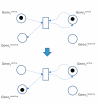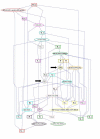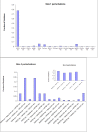Minimally perturbing a gene regulatory network to avoid a disease phenotype: the glioma network as a test case
- PMID: 20184733
- PMCID: PMC2851584
- DOI: 10.1186/1752-0509-4-15
Minimally perturbing a gene regulatory network to avoid a disease phenotype: the glioma network as a test case
Abstract
Background: Mathematical modeling of biological networks is an essential part of Systems Biology. Developing and using such models in order to understand gene regulatory networks is a major challenge.
Results: We present an algorithm that determines the smallest perturbations required for manipulating the dynamics of a network formulated as a Petri net, in order to cause or avoid a specified phenotype. By modifying McMillan's unfolding algorithm, we handle partial knowledge and reduce computation cost. The methodology is demonstrated on a glioma network. Out of the single gene perturbations, activation of glutathione S-transferase P (GSTP1) gene was by far the most effective in blocking the cancer phenotype. Among pairs of perturbations, NFkB and TGF-beta had the largest joint effect, in accordance with their role in the EMT process.
Conclusion: Our method allows perturbation analysis of regulatory networks and can overcome incomplete information. It can help in identifying drug targets and in prioritizing perturbation experiments.
Figures






References
-
- Noble D. The music of life: biology beyond the genome. Oxford: Oxford University Press; 2006.
-
- Ihekwaba AE, Broomhead DS, Grimley R, Benson N, White MR, Kell DB. Synergistic control of oscillations in the NF-kappaB signalling pathway. Syst Biol. 2005;152:153–160. - PubMed
Publication types
MeSH terms
Substances
LinkOut - more resources
Miscellaneous
